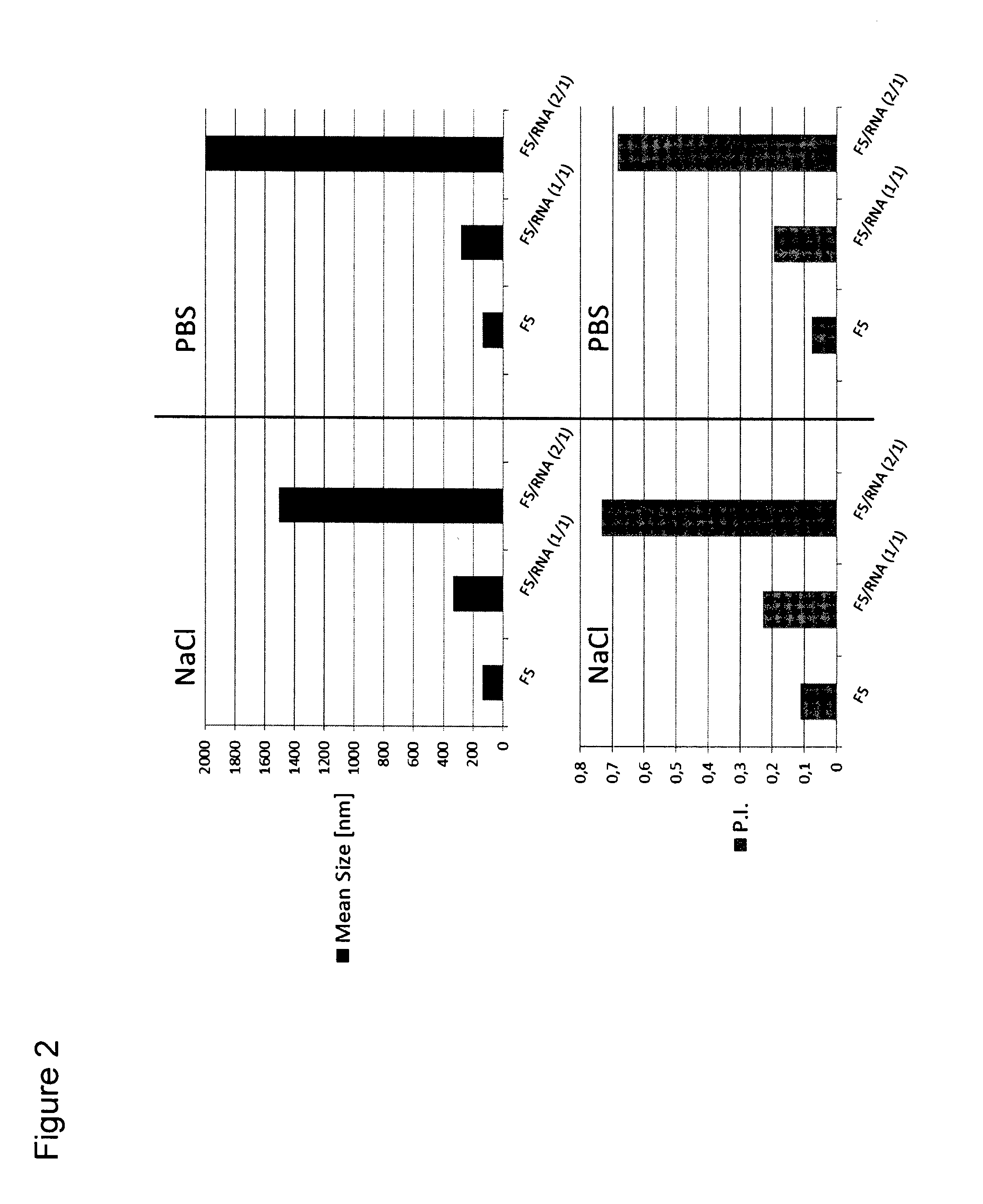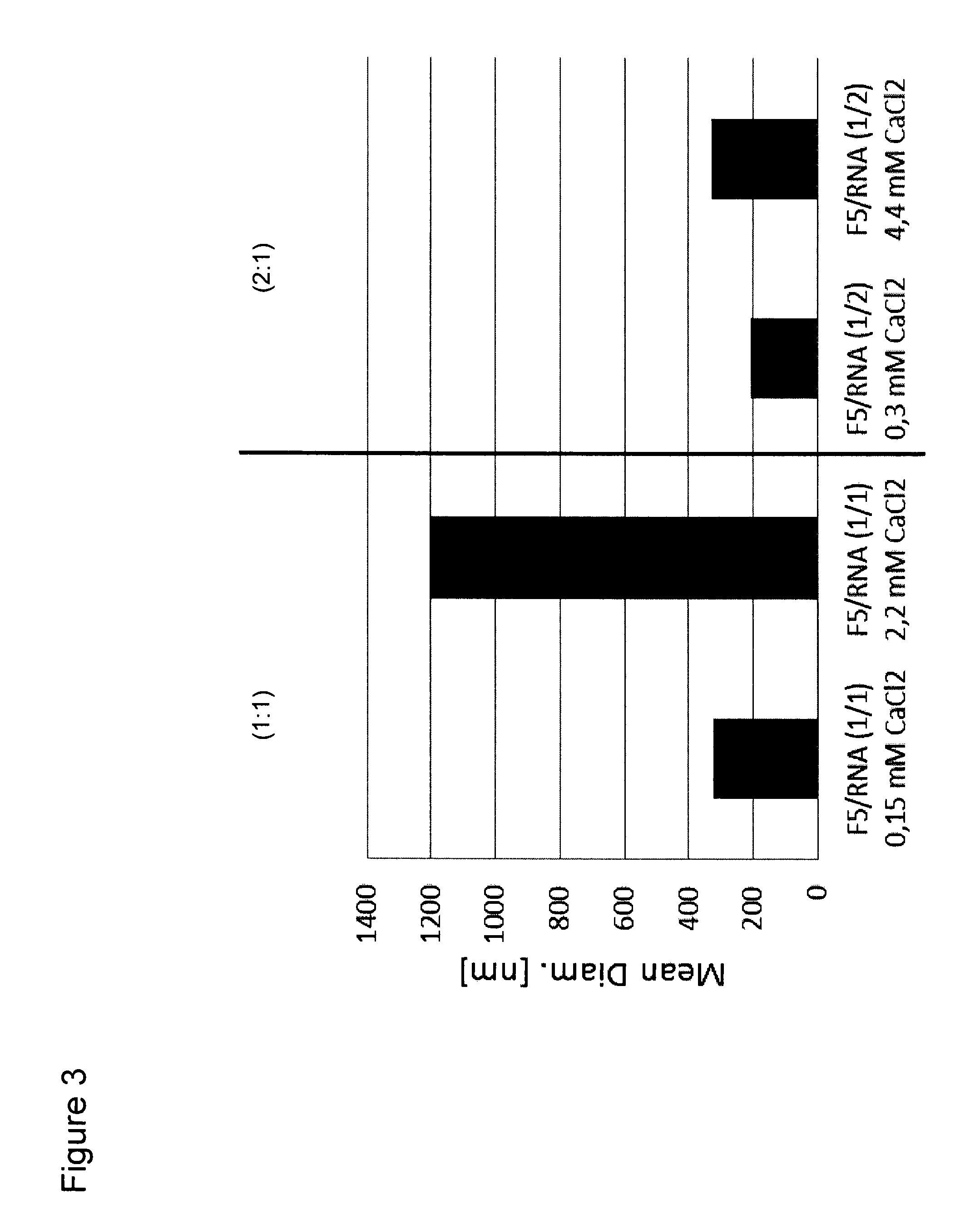RNA Formulation for Immunotherapy
a technology of immunotherapy and formulation, applied in the field of immunotherapy, can solve the problems of avoiding expression in off-target organs, requiring specific skills, and insufficient realization, and achieve the effect of minimizing adverse effects
- Summary
- Abstract
- Description
- Claims
- Application Information
AI Technical Summary
Benefits of technology
Problems solved by technology
Method used
Image
Examples
example 1
Materials and Methods
Liposome Preparation
[0283]Manufacturing of liposomes was performed by different protocols. The ‘film method’ or ‘ethanol injection’ was used for liposome preparation. For the film method, the lipids were dissolved in chloroform and put in appropriate amounts into a round bottom flask. The organic solvent was evaporated in a rotary evaporator and the dry film was reconstituted with water or buffer / excipient solution by gently shaking of the flask. Typically, a total lipid concentration of 5 mM was selected. For ethanol injection, the lipids were dissolved at suitable molar ratios in ethanol to a total concentration in the range of 100-400 mM. The ethanol solution was injected under stirring into water or the aqueous solution of buffers / excipients. The size of the liposomes was adjusted by extrusion across polycarbonate membranes of different pore size (50-400 nm), and / or they were filtered through commercially available sterile filters of 220-450 nm pore size, or...
example 2
Effect of Buffers / Ions on Particle Sizes and PI of RNA Lipoplexes
[0300]Lipoplexes of liposomes and RNA at different charge ratios + / − between the cationic (positively charged) lipid DOTMA and the negatively charged RNA were prepared. The physiochemical characteristics of the liposomes were investigated by dynamic light scattering (PCS) and zeta potential measurements.
[0301]The use of buffer which is often necessary for pharmaceutical applications and ions can lead to aggregation of lipoplexes which makes them unsuitable for parenteral application to patients. In order to evaluate these effects on the average diameter of lipoplexes, the particle characteristics of lipoplexes of DOTMA / DOPE (F4) liposomes [DOTMA / DOPE (1:1 mol:mol)] and RNA at different charge ratios were determined under four buffer conditions, namely, water, PBS buffer, PBS plus 2.2 mM CaCl2, and PBS plus 22 mM CaCl2. For the measurements, briefly, lipoplexes were formed by adding of RNA to preformed liposomes, subseq...
example 3
Effect of Positive Charge on Stability of RNA Lipoplexes
[0307]For an additional evaluation of a potential beneficial / detrimental effect of positive charges on the stability of lipoplexes (see e.g. FIG. 1b and c), particle sizes of lipoplexes of DOTMA / Chol liposomes (F5) [DOTMA / Chol (1:1 mol:mol)] and RNA with DOTMA / RNA charge ratios of 1 / 1 and 2 / 1 were measured in different buffers (see FIG. 2). For comparison, also the size of the pure liposomes was measured.
[0308]In 150 mM sodium chloride as well as in PBS buffer a positive 2 / 1 DOTMA / RNA charge ratio leads to largely increased / aggregated particle sizes with a polydispersity index greater than 0.4. This result indicates that positive charges are not suitable to stabilize lipoplexes and that aggregation has to be expected for the positively charged lipoplexes also under physiological conditions.
PUM
| Property | Measurement | Unit |
|---|---|---|
| diameter | aaaaa | aaaaa |
| diameter | aaaaa | aaaaa |
| diameter | aaaaa | aaaaa |
Abstract
Description
Claims
Application Information
 Login to View More
Login to View More - R&D
- Intellectual Property
- Life Sciences
- Materials
- Tech Scout
- Unparalleled Data Quality
- Higher Quality Content
- 60% Fewer Hallucinations
Browse by: Latest US Patents, China's latest patents, Technical Efficacy Thesaurus, Application Domain, Technology Topic, Popular Technical Reports.
© 2025 PatSnap. All rights reserved.Legal|Privacy policy|Modern Slavery Act Transparency Statement|Sitemap|About US| Contact US: help@patsnap.com



